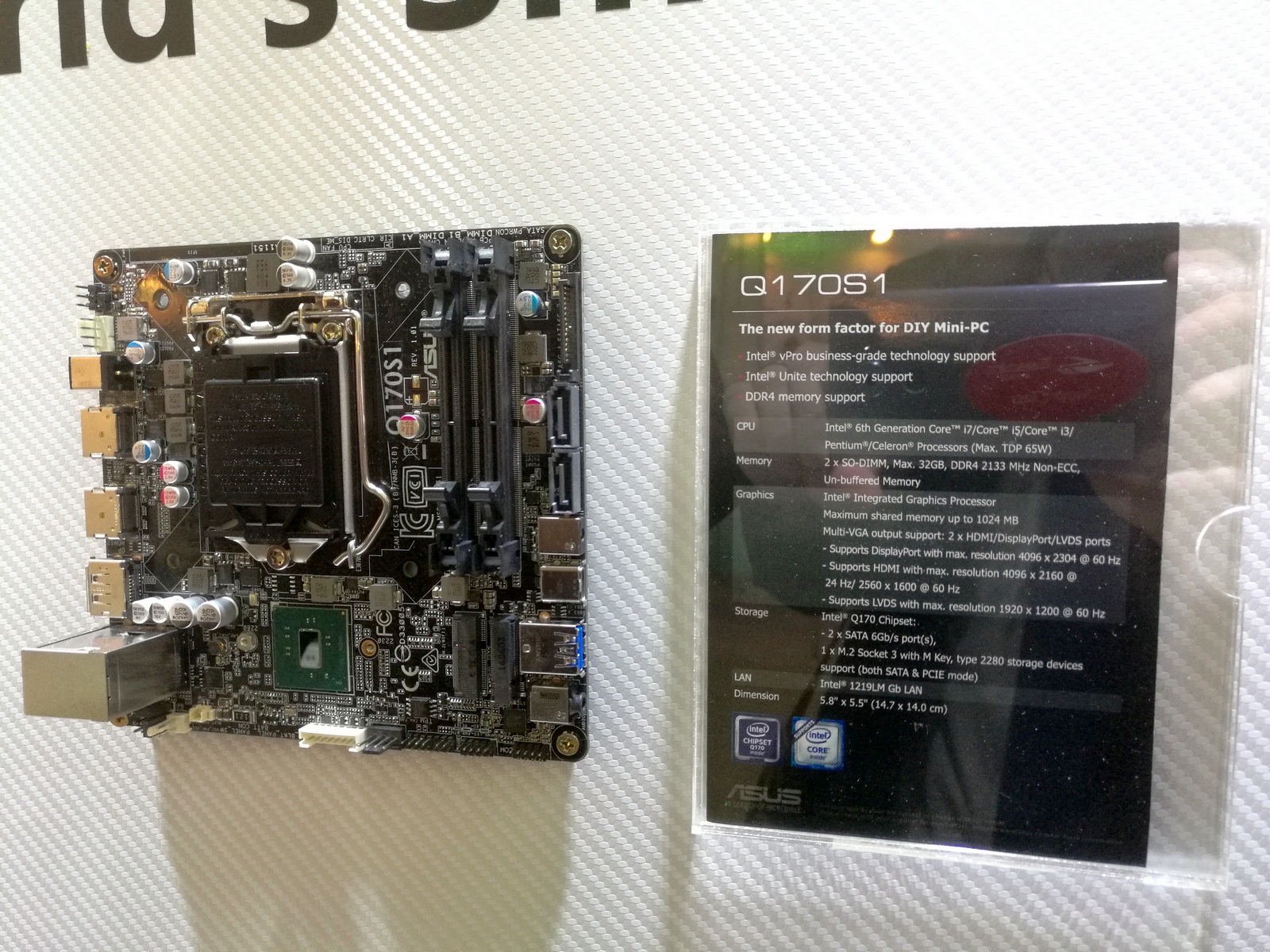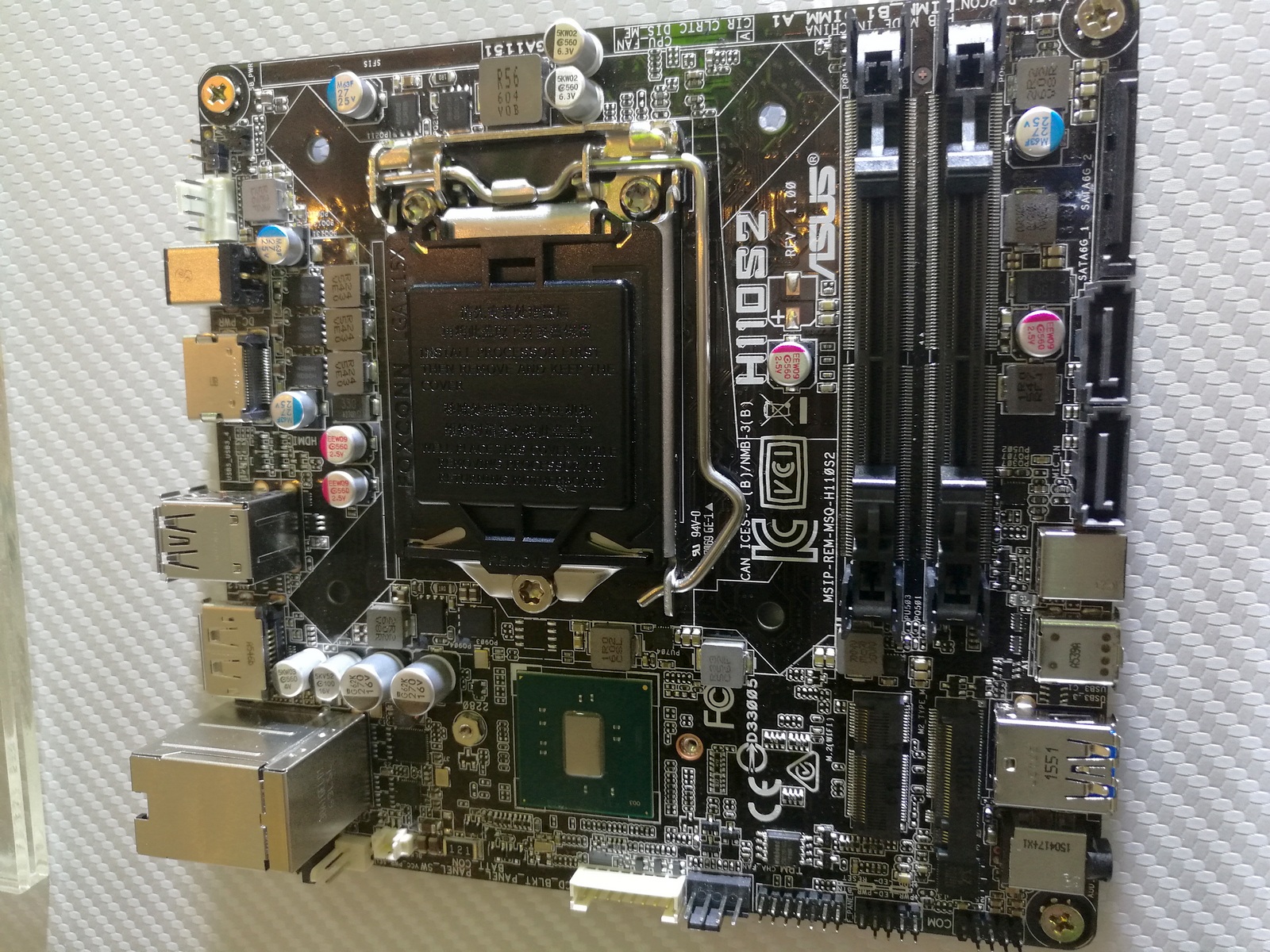ASUS at Computex 2016: The 10 Years of the Republic Of Gamers (ROG) Booth Tour
by Ian Cutress on June 22, 2016 8:00 AM ESTThe three major form factors for custom build personal computers, in order of popularity, are ATX, followed by micro-ATX and then mini-ITX. That also happens to be the order of size as well, from largest to smallest. Earlier in this piece we spoke about how motherboard design has not really changed from these three as of late, mostly due to compatibility and how everything in the industry currently works. However, at IDF in 2015, Intel announced a new form factor for mini-PCs relying purely on integrated graphics: the Mini-STX platform (also known as 5x5, for 5-inch square).
5x5
Before I left for Computex, I asked our editors want they knew would be at the show and what they would like me to cover. One of the responses from Ganesh was ‘anything Mini-STX’. We saw a couple of things at CES, although mostly pre-built mSTX systems. Luckily for Ganesh, ASUS had three motherboards on display.
The first up is the Q170S1, using the Q-series chipset for business level customers and vPro support. We haven’t typically covered the Q-series at AnandTech, however the Q170 attempts to mirror a lot of what the Z170 does but under the provision of a professional grade, managed system that doesn’t go into Xeon. This includes business level support, a separate firmware with control options, and a number of other things. There is an extra cost to the Q-series over the H-series chipsets, around $12 list price, but for the business side benefits this is usually a small price for manageability. In this case, the Q170S1 can use any Skylake processor up to 65W (up to i7-6700), two DDR4 SO-SIMM modules, and supports M.2, SATA, M.2 for WiFi, and rear panel 19V power. All graphics capabilities come from the CPU, and there’s also a vPro enabled network port to facilitate network control.
On the cheaper side of the coin are the H-series variants. These are strikingly similar in board layout, with the S2 version having dual network ports (one Intel I219-V and one Realtek 8111H) whereas the S1 version only has a single Intel I219-V. Specifications match up to the Q170S1 motherboard otherwise, with 65W processor support, but nothing vPro related.
Mini-STX is a drive for Intel towards the more industrial side of the market that wants upgradability. There are a number of platforms already in that space, such as the Intel NUC, Core-M, Atom, ECS LIVA, the MSI Cubi and others, however they are all using soldered down processors. Mini-STX enables a bit more customization within Intel’s platform structure, as well as more performance.













43 Comments
View All Comments
A5 - Wednesday, June 22, 2016 - link
End users who are buying Broadwell-E are almost always doing it for 3+ way SLI reasons, which pretty much forces you into full ATX.They presumably have research (or data from the past) that says they will not sell enough mATX boards with HEDT chipsets to be worth the engineering effort.
Bragabondio - Wednesday, June 22, 2016 - link
Well now that Nvidia would not support more than 2 cards SLI (except for benchmarking applications) the argument for 3 way SLI becomes moot. (micro ATX supports 2 way SLI). Starting to think we will be stuck with 4 core CPUs for the next 5+ years unless ZEN is a huge success.Sushisamurai - Wednesday, June 22, 2016 - link
uhhh... Nvidia still has 3 way/4 way SLI - they've only restricted SLI requirements to PCIe x8, versus AMD's crossfire x4; presumably to maintain a performance target. With "consumer" lines of Intel CPU's, you only get max 20 PCIe lanes (correct me if I'm wrong), allowing only 2 way SLI. HEDT chips have 28 to 40 to 40. Hence, 3 way to 4 way SLI is pretty much restricted purely to HEDT. Anandtech had an article about CPU/PCIe bottleneck with SLI/CF a ?few years back. If memory serves me correctly, PCIe x4 bottlenecks modern high end GPU's, and an i5 can run 2 high end GPU's without bottlenecking - it is when you go 3 cards you'll need an i7 for gaming (assuming you have enough lanes), and HEDT (my opinion now) if you want 4 cards (due to PCIe lanes, and enough cores to feed the cards)Bragabondio - Wednesday, June 22, 2016 - link
Correct until GTX 1070&1080 were introduced. Starting with the GeForce GTX 1080, Nvidia is discontinuing official support for 3-way and 4-way multi-GPU SLI setups.http://www.pcworld.com/article/3071332/hardware/it...
Sushisamurai - Thursday, June 23, 2016 - link
Oh that is messed up. I've read their white paper, didn't even know they trashed the enthusiast key option. Wow that's super unfortunate.alphasquadron - Wednesday, June 22, 2016 - link
"So I don't understand why manufacturers don't want my money?"I think they do but as stated in the article:
"The three major form factors for custom build personal computers, in order of popularity, are ATX, followed by micro-ATX and then mini-ITX."
I too am waiting for an external dock that I can plug my laptop into and achieve 80-90% of performance of a full size desktop. Whoever makes this will have grabbed two markets. Those who want a gaming desktop and are okay with huge cases (usually younger) and professionals like me who want the same but would never get a gigantic case. If we can get an external dock that tries to be compatible with most laptops as much as possible without looking like an eyesore and can deliver close to desktop performance, it would be an instant buy for a lot of people. As you now have a laptop and desktop. Though I think that this would come from a laptop manufacturer as if it was very well made and successful, I would think the market that would buy a desktop over a laptop for 10% gain in performance would be very small.
Bragabondio - Wednesday, June 22, 2016 - link
Guess I have to give my dream for small but super powerful desktop PC and embrace the reality that laptop/surface device + dock is the future for the middle aged professional :)Bragabondio - Wednesday, June 22, 2016 - link
One more thing. The ATX may be indeed most popular size but that is mostly due to tradition not function as 99% of the consumer market don't need/use all the slots and space of a larger ATX case. That is why I like project Avalon but nobody knows if it ever would become a reality.Ananke - Wednesday, June 22, 2016 - link
Unfortunately, in the current moment of the high tech industry, "middle age" is very inappropriate. Companies think their teen- and twenty-year old customers have many thousands of disposable income , and cater to them exclusively. Besides, young people buy easily obsolete or inferior tech, since they don't have comparison base :):). The only problem for the tech industry is, that younger population usually has no disposable income /and that's kinda universal truth over many centuries/ and just doesn't buy because it can't pay.Bragabondio - Wednesday, June 22, 2016 - link
well said Ananke! Plus, as a coup de grace now we have to deal with gazillion of RGB lights inside our cases - if I wanted a freaking X-mas tree inside my case I would have bought one ! :)